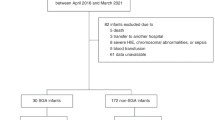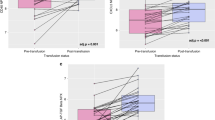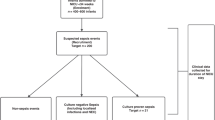Abstract
BACKGROUND:
Thrombopoietin (TPO) is a growth factor that controls platelet production. Despite the known association of chronic hypoxia and acute asphyxia with hematologic changes, TPO had not been studied in neonatal asphyxia.
OBJECTIVE:
To assess TPO concentrations in the serum of asphyxiated and nonasphyxiated neonates, and examine any correlation with the severity of asphyxia.
DESIGN/METHODS:
This prospective study was carried out on 32 asphyxiated neonates and 30 control subjects admitted at Cairo University Medical Center. Asphyxia was defined if two of the following were found: (1) Apgar score ≤3 at 1 minute or ≤6 at 5 minutes, (2) umbilical cord arterial pH ≤7.2 combined with base deficit ≥−10 and (3) clinical evidence of perinatal asphyxia. Encephalopathy was classified clinically according to Sarnat's stages during the first day of life. Platelet count and TPO level (pg/ml) were measured at 1st, 3rd and 7th day of life.
RESULTS:
TPO measured on the first day of life did not differ between cases and controls (900.2±526.4 vs 726.6±441.9 pg/ml, p=0.2). It increased on the 3rd day of life and was significantly higher in asphyxiated infants compared to controls (1291.4±627.9 vs 885.5±400.3 pg/ml, respectively; p=0.004). This difference remained significant in a logistic regression model controlling for birth weight, sex and mode of delivery (regression coefficient=476.9±146.8; p=0.002). In asphyxiated infants (n=32), encephalopathy was classified as mild (n=17), moderate (n=10) and severe (n=5). TPO correlated with the degree of clinical severity on the 7th day of life (r=0.59, p=0.003). TPO did not differ between survivors (n=24) and nonsurvivors (n=8) within the asphyxia group (1197.1±596.8 vs 1613.1±605.9 pg/ml; p=0.09). Platelet counts correlated negatively with TPO measured on day 1 (r=−0.415; p=0.02), day 3 (r=−0.64; p=0.001) and day 7 (r=−0.562; p=0.007).
CONCLUSIONS:
TPO increased and correlated with severity of asphyxia at 3 and 7 days of life. It correlated negatively with the platelet count at all times.
This is a preview of subscription content, access via your institution
Access options
Subscribe to this journal
Receive 12 print issues and online access
$259.00 per year
only $21.58 per issue
Buy this article
- Purchase on Springer Link
- Instant access to full article PDF
Prices may be subject to local taxes which are calculated during checkout



Similar content being viewed by others
References
World Health Organization. Child Health and Development: Health of the Newborn. Geneva: World Health Organization; 1991.
Leviton A, Dammann O . Coagulation, inflammation, and the risk of neonatal white matter damage. Pediatr Res 2004;55:541–545.
Wendling F, Maraskovsky E, Debili N, et al. c-Mpl ligand is a humoral regulator of megakaryocytopoiesis. Nature. 1994;369:571–574.
Murray NA, Watts TL, Roberts IA . Thrombopoietin in the fetus and neonate. Early Hum Dev 2000;59:1–12.
Bunting S, Widmer R, Lipari T, et al. Normal platelets and megakaryocytes are produced in vivo in the absence of thrombopoietin. Blood 1997;90:3423–3429.
Broudy VC, Lin NL, Kaushansky K . Thrombopoietin (c-mpl ligand) acts synergistically with erythropoietin stem cell factor and interleukin-11 to enhance murine megakaryocyte colony growth and increases megakaryocyte ploidy in vitro. Blood 1995;85:1719–1726.
Hudson JG, Bowen AL, Navia P, et al. The effect of high altitude on platelet counts, thrombopoietin and erythropoietin levels in young Boliviam airmen visiting the Andes. Int J Biometeorol 1999;43:85–90.
Ikeno K, Koike K, Takeshita A, et al. Stressful delivery influences circulating thrombopoietin (TPO) levels in newborns: possible role for cortisol in TPO-mpl binding. Early Hum Dev 2000;58:225–235.
Hobisch-Hagen P, Jelkmann W, Mayr A, et al. Low platelet count and elevated serum thrombopoietin after severe trauma. Eur J Haematol 2000;64:157–163.
Glistrap LC, Levono KJ, Burris J, et al. Diagnosis of birth asphyxia on the basis of fetal pH, Apgar score and newborn cerebral dysfunction. Am J Gynecol Obstet 1989;161:825–830.
Sarnat HB, Sarnat MS . Neonatal encephalopathy following fetal distress. Arch Neurol 1976;33:696–705.
Sola MC, Del Vecchio A, Rimsza LM . Evaluation and treatment of thrombocytopenia in the neonatal intensive care unit. Clin Perinatol 2000;27:655–679.
Blackwell SC, Refuerzo JS, Hassan SS, Wolfe HM, Sorokin Y . Nucleated red blood cell counts in term neonates with umbilical artery pH ≤7.00. Am J Perinatol 2001;18:93–98.
Bekedam DJ, Engelsbel S, Mol BW, Buitendijk SE, van der Pal-de Bruin KM . Male predominance in fetal distress during labor. J Obstet Gynecol 2002;187:1605–1607.
Lieberman E, Lang JM, Cohen AP, Frigoletto Jr FD, Acker D, Rao R . The association of fetal sex with the rate of cesarean section. Am J Obstet Gynecol 1997;176:667–671.
Dawes NW, Dawes GS, Moulden M, Redman GW . Fetal heart rate patterns in term labor vary with sex, gestational age, epidural analgesia and fetal weight. Am J Obstet Gynecol 1999;180:181–187.
Edwards A, Megens A, Peek M, Wallace EM . Sexual origins of placental dysfunction. Lancet 2000;355:203–204.
Clarke C, Mittwoch U . Changes in the male to female ratio at different stages of life. Br J Obstet Gynaecol 1995;102:677–679.
Lynn CS, Wallwork JC . Does food restriction retard aging by reducing metabolic rate? J Nutr 1992;122:1917–1918. How does this relate to your study?
Albert TS, Meng YG, Simms P, Cohen RL, Phibbs RH . TPO in the thrombocytopenic term and preterm newborn. Pediatrics 2000;105:1286–1291.
Alexander WS . Thrombopoietin. Growth Factors 1999;17:13–24.
Dreyfus M, Kaplan C, Verdy E, Schlegel N, Durand-Zaleski I, Tchernia G . Frequency of immune thrombocytopenia in newborns: A prospective study. Immune thrombocytopenia working group. Blood 1997;89:4402–4406.
Emmons RV, Reid DM, Cohen RL, et al. Human thrombopoietin levels are high when thrombocytopenia is due to megakaryocyte deficiency and low when due to increased platelet destruction. Blood 1996;87:4068–4071.
Author information
Authors and Affiliations
Corresponding author
Rights and permissions
About this article
Cite this article
Aly, H., Beshlawy, A., Badrawi, N. et al. Thrombopoietin Level Is Increased in the Serum of Asphyxiated Neonates: A Prospective Controlled Study. J Perinatol 25, 320–324 (2005). https://doi.org/10.1038/sj.jp.7211287
Published:
Issue Date:
DOI: https://doi.org/10.1038/sj.jp.7211287
This article is cited by
-
Lipid peroxides in the serum of asphyxiated neonates
Journal of Perinatology (2016)
-
Serum amyloid A protein and hypoxic ischemic encephalopathy in the newborn
Journal of Perinatology (2011)
-
Serum thrombopoietin level and thrombocytopenia during the neonatal period in infants with Down's syndrome
Journal of Perinatology (2010)



